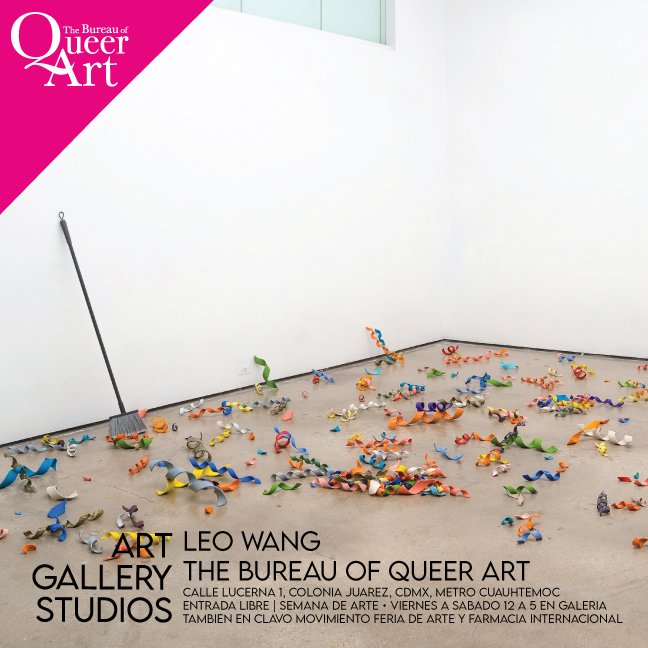Supporting Queer Art has never been so easy.
Let the highest bid WIN!
ISupport the vibrant future of queer art! By placing a high bid, you're directly contributing to The Bureau of Queer Art's community exhibitions, publications, residencies, and cross-border projects that build and enrich our community. Remember, winning a bid is a commitment—payment must be made via a secure PayPal invoice, which can be completed using bank or credit card information within five business days. Artwork will be available for pickup from Dama Gallery in Ventura, CA, or shipped on June 2nd, 2024 at the cost of bid winner. Your generous support enables us to continue making a meaningful impact. Bid generously and support passionately!
(View Auction Item and other artworks available outside auction below - All work is unframed)
AUCTION ITEM
Caution! Dance Floor, 2023, EDITION ARTWORK 1/49
- EACH ONE IS DIFFERENT - Print Media Installation silk screen prints unframed set of three shown - 19 x 25 inches, 48.26 x 63.5 cm
Set of 3 $650 | Estimated Value
Starting Bid $50
Print & Media
ENTRE LAS BOLAS DE DiSCOTECA Y LA FiLOSOFÍA: LEO WANG
ARTiSTA @MADEBYLEOWANG
En el vibrante y cambiante paisaje de Chicago, donde la grandeza de la arquitectura se encuentra con la serena belleza del lago Michigan, descubrimos el refugio creativo del escultor y artista de instalaciones Leo Wang. La ciudad, conocida por su clima impredecible, proporciona más que solo un telón de fondo para Wang; es una fuente de inspiración, alimentando su mezcla única de humor, rico simbolismo y diálogos culturales estratificados. La conexión de Wang con Chicago se profundizó durante sus estudios de posgrado en la Escuela del Instituto de Arte de Chicago (SAIC), donde el entorno dinámico de la ciudad influenció su viaje artístico.
Una de las obras más cautivadoras de Wang es “Precaución en la Pista de Baile”, una pieza que transforma el mundano letrero de “Piso Mojado” en una profunda declaración sobre las complejidades de la cultura de clubes y fiestas. El letrero, típicamente una simple advertencia, se convierte en una puerta de entrada para explorar la dinámica matizada de la vida nocturna. La obra de Wang no trata solo sobre el espacio físico del club, sino también sobre su papel como arena sociocultural, un lugar de entretenimiento y reflexión, donde se desarrolla el gran drama de la vida.
El arte de Wang se caracteriza por una mezcla de humor, precaución y estimulación visual. Eleva objetos ordinarios a arte de alto nivel, llamando la atención sobre los aspectos absurdos y a menudo peligrosos de la cultura de clubes. El letrero de precaución en su obra es una advertencia tanto literal como metafórica, tocando temas desde el consentimiento hasta el abuso de sustancias, e instando a los espectadores a reflexionar sobre los límites del placer y la naturaleza efímera del placer.
El artista también involucra los sentidos con colores vívidos, materiales eclécticos y disposiciones espaciales únicas, haciendo del letrero de precaución un espectáculo que refleja el atractivo de los ambientes de clubes. Al hacerlo, Wang crea una experiencia multicapa, invitando a los espectadores a un diálogo que trasciende lo visible y lo táctil.
La exploración de Wang de la cultura de clubes se extiende verticalmente en sus instalaciones, creando una experiencia dual de voyeurismo y compromiso. Su obra captura las dicotomías del mundo de los clubes, un espacio que es tanto liberador como confinante, un santuario y un campo de batalla. Describe el club como una “utopía temporal” que pausa momentáneamente los problemas del mundo real sin resolverlos.
“Una Flor en el Espejo, Luna en el Agua” es otra de las obras notables de Wang, donde entrelaza elementos de la filosofía tradicional china con la extravagancia moderna. Su posición como curador en el Museo Americano Chino añade profundidad a su arte, fomentando un diálogo global sobre la identidad cultural y las experiencias humanas compartidas.
La luz roja es un motivo recurrente en las instalaciones de Wang, simbolizando tanto la vitalidad de la vida como sus peligros potenciales. Este elemento critica la seguridad percibida de ciertos entornos, resaltando los complejos paisajes sociales y emocionales que navegamos.
En “Confeti”, Wang profundiza en la naturaleza de la celebración y la alegría. La instalación, que presenta confeti de cerámica, contrasta la permanencia del material con la transitoriedad de los momentos alegres. La inclusión de una escoba significa el inevitable retorno a la realidad después del éxtasis, reforzando el tema de la temporalidad.
La iluminación dual en “Confeti”, luces de club coloridas y brillantes luces de galería, representa el equilibrio entre el escapismo y el retorno a la realidad, reminiscente de los momentos finales de una noche de fiesta. Esta instalación invita a la reflexión sobre la naturaleza cíclica de las emociones humanas, capturando tanto el pico de la celebración como la calma del amanecer.
El trabajo de Wang no es solo un estudio en contrastes; es un diálogo complejo que navega identidades culturales, precaución, liberación y la interacción entre lo efímero y lo duradero.
BETWEEN DiSCO BALLS AND PHiLOSOPHY:
LEO WANG
ARTiST @MADEBYLEOWANG
In the vibrant, ever-changing landscape of Chicago, where the grandeur of architecture meets the serene beauty of Lake Michigan, we discover the creative haven of sculptor and installation artist Leo Wang. The city, known for its unpredictable weather, provides more than just a backdrop for Wang; it’s a source of inspiration, fueling his unique blend of humor, rich symbolism, and layered cultural dialogues. Wang’s connection with Chicago deepened during his graduate studies at the School of the Art Institute of Chicago (SAIC), where the city’s dynamic environment influenced his artistic journey.
One of Wang’s most captivating works is “Caution on the Dance Floor,” a piece that transforms the mundane ‘Caution Wet Floor’ sign into a profound statement on the complexities of club and party culture. The sign, typically a simple warning, becomes a gateway to explore the nuanced dynamics of nightlife. Wang’s work is not just about the physical space of the club but also its role as a socio-cultural arena, a place of both entertainment and reflection, where life’s grand drama unfolds.
Wang’s art is characterized by a blend of humor, caution, and visual stimulation. He elevates ordinary objects to high art, drawing attention to the absurd and often dangerous aspects of club culture. The caution sign in his work is both a literal and metaphorical warning, touching on themes from consent to substance abuse, and urging viewers to ponder the boundaries of indulgence and the fleeting nature of pleasure.
The artist also engages the senses with vivid colors, eclectic materials, and unique spatial arrangements, making the caution sign a spectacle that mirrors the allure of clubbing environments. In doing so, Wang creates a multilayered experience, inviting viewers into a dialogue that transcends the visible and tactile.
Wang’s exploration of club culture extends vertically in his installations, creating a dual experience of voyeurism and engagement. His work captures the dichotomies of the clubbing world – a space that is both liberating and confining, a sanctuary and a battleground. He describes the club as a “temporary utopia” that momentarily pauses real-world issues without resolving them.
“A Flower in the Mirror, Moon in the Water” is another of Wang’s notable works, where he intertwines elements of traditional Chinese philosophy with modern extravagance. His position as a curator at the Chinese American Museum adds depth to his art, fostering a global dialogue on cultural identity and shared human experiences.
Red light is a recurring motif in Wang’s installations, symbolizing both life’s vibrancy and its potential dangers. This element critiques the perceived safety of certain environments, highlighting the complex social and emotional landscapes we navigate.
In “Confetti,” Wang delves into the nature of celebration and joy. The installation, featuring ceramic confetti, contrasts the permanence of the material with the transience of joyous moments. The inclusion of a broom signifies the inevitable return to reality after ecstasy, reinforcing the theme of temporality.
The dual lighting in “Confetti” – colorful club lights and bright gallery lights – represents the balance between escapism and the return to reality, reminiscent of the concluding moments of a night out. This installation invites reflection on the cyclical nature of human emotions, capturing both the peak of celebration and the calm of dawn.
Wang’s work is not just a study in contrasts; it’s a complex dialogue that navigates cultural identities, caution, liberation, and the interplay between the fleeting and the enduring. His art offers a unique perspective in a world where understanding our complicated identities and spaces is increasingly important.
For those intrigued by Wang’s artistic narrative, further exploration is available. Visit Dabster Arts Inc. on Artsy.net to experience his work. Additionally, to delve deeper into Wang’s philosophy and artistry, download The Bureau of Queer Art Volume 2 or listen to the podcast interview in Season 2 at ArtGalleryStudios.com. Leo’s work will also be showcased at Clavo Movimiento Art Fair during Art Week CDMX 2024.
Leo Wang’s art serves as a guide through the complex landscapes of contemporary life, encouraging us to question, discover, and dance through life’s gallery. The Bureau of Queer Art stands as a beacon for those journeying through the realms of art and self-expression.

